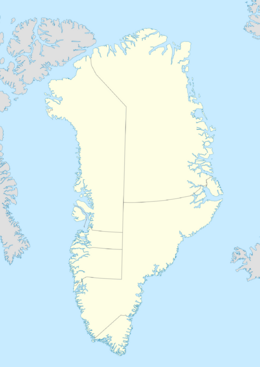Earth:Akilia
| Geography | |
|---|---|
| Coordinates | [ ⚑ ] : 63°56′23″N 51°40′29″W / 63.93972°N 51.67472°W |
| Adjacent bodies of water | Davis Strait |
| Area | 138 ha (340 acres) |
| Administration | |
| Municipality | Sermersooq |
| Demographics | |
| Population | 0 (2023) |
| Pop. density | 0/km2 (0/sq mi) |
Akilia Island is an island in southwestern Greenland, about 22 kilometers south of Nuuk. Akilia is the location of a rock formation that has been proposed to contain the oldest known sedimentary rocks on Earth,[1][2] and perhaps the oldest evidence of life on Earth.[3]
Geology
The rocks in question are part of a metamorphosed supracrustal sequence located at the south-western tip of the island. The sequence has been dated as no younger than 3.85 billion years old - that is, in the Hadean eon - based on the age of an igneous band that cuts the rock.[4] The supracrustal sequence contains layers rich in iron and silica, which are variously interpreted as banded iron formation, chemical sediments from submarine hot springs, or hydrothermal vein deposits. Carbon in the rock, present as graphite, shows low levels of carbon-13,[3] which may suggest an origin as isotopically light organic matter derived from living organisms.[5] However, this interpretation is complicated because of high-grade metamorphism that affected the Akilia rocks after their formation. The sedimentary origin, age and the carbon content of the rocks have been questioned.[6][7][8]
If the Akilia rocks do show evidence of life by 3.85 Ga, it would challenge models which suggest that Earth would not be hospitable to life at this time.
See also
- List of islands of Greenland
- Origin of life
References
- ↑ McGregor, VR, Mason, B (1977 Petrogenesis and geochemistry of metabasaltic and metasedimentary enclaves in the Amîtsoq gneisses, West Greenland. American Mineralogist, v. 62, p. 887-904
- ↑ Nutman AP, Mojzsis, SJ, Friend, CRL (1997) Recognition of ≥3850 Ma water-lain sediments in West Greenland and their significance for the early Archaean Earth. Geochimica et Cosmochimica Acta, v. 61, p. 2475-2484.
- ↑ Jump up to: 3.0 3.1 Mojzsis, SJ, Arrhenius, G, McKeegan, KD, Harrison, TM, Nutman, AP, Friend, CRL (1996) Evidence for life on Earth before 3,800 million years ago. Nature, v. 384, p. 55-59
- ↑ Manning, CE, Mojzsis, SJ, Harrison, TM (2006) Geology, age and origin of supracrustal rocks at Akilia, West Greenland. American Journal of Science, v. 206, p. 303-366
- ↑ Schidlowski, M (1988) A 3,850-Million-Year Isotopic Record of Life From Carbon in Sedimentary-Rocks. Nature, v. 333, p. 313-318
- ↑ Myers, JS, Crowley, JL (2000) Vestiges of life in the oldest Greenland rocks? A review of early Archean geology in the Godthåbsfjord region, and reappraisal of field evidence for >3850 Ma life on Akilia. Precambrian Research, v. 103, p. 101-124.
- ↑ Fedo, CM, Whitehouse, MJ (2002) Metasomatic origin of quartz-pyroxene rock, Akilia, Greenland, and implications for Earth's earliest life. Science, v. 296, p. 1448-1452
- ↑ Lepland, A, van Zuilen, M, Arrhenius, G, Whitehouse, M, Fedo, C (2005) Questioning the evidence for Earth's earliest life—Akilia revisited. Geology, v. 33, p. 77-79
External links
- Scientists Disagree over How, When Life Began on Earth
- Information on Nuuk, Greenland
- Study Resolves Doubt About Origin Of Earth’s Oldest Rocks, Possibility Of Finding Traces Of Ancient Life
- UCLA scientists strengthen case for life more than 3.8 billion years ago
 |


